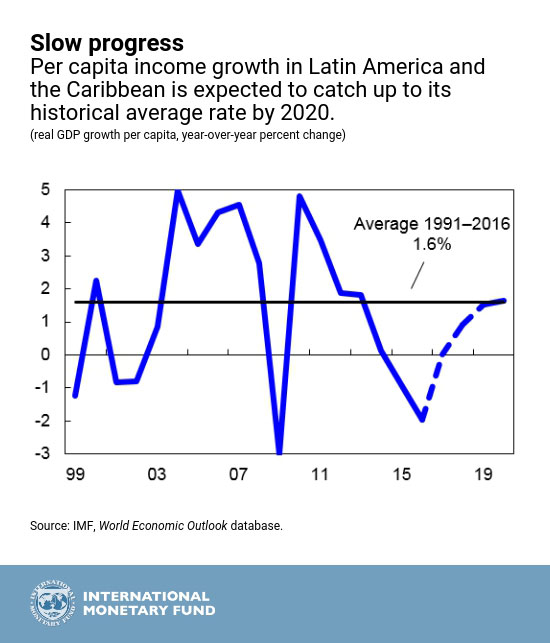July 25, 2017
Versions in Español (Spanish), Português (Portuguese)
[caption id="attachment_20737" align="alignnone" width="1024"] Shopping mall in Viña del Mar, Chile: Latin America is expected to recover gradually as most economies continue to face weak domestic demand (photo: Rodrigo Garrido/Newscom)[/caption]
Shopping mall in Viña del Mar, Chile: Latin America is expected to recover gradually as most economies continue to face weak domestic demand (photo: Rodrigo Garrido/Newscom)[/caption]
After disappointing growth over the past few years, economic activity in Latin America remains on track to recover gradually in 2017–18 as recessions in a few countries—notably Argentina and Brazil—are coming to an end. Our latest projections show the region growing by 1 percent in 2017 and 1.9 percent in 2018.
But amid low confidence, domestic demand continues to remain weak across most economies, and is expected to only recover slowly as actual output catches up to potential and internal sources of growth build strength, based on a decline in political and policy uncertainty across some major economies. Some countries in the region will need clear strategies to adjust further following a permanent loss in commodity revenues.
Reverting to an underwhelming mean
Where is this gradual recovery expected to lead? Prospects for strong long-term growth in Latin America look dimmer now than they did a few years ago at the height of the commodity price boom. Over the medium term, we project Latin America to grow approximately 1.6 percent in per capita terms. This is identical to the region’s performance over the past quarter century—a figure that is well below the rates observed for the group of emerging and developing economies (2.6 percent) and vastly below the growth rates in China (9 percent). Worryingly, these growth rates are essentially equal to that of advanced economies, suggesting that the region as a whole is not converging to their income levels. Furthermore, the small contribution of productivity to overall growth calls into question its sustainability, particularly as the region prepares to face a demographic transition to an older population that will limit labor supply growth.
A central challenge Latin America and the Caribbean will face going forward is to preserve (and build upon) the success achieved in recent years in improving living standards. With medium-term growth projected to remain modest and fiscal space increasingly scarce, countries need to pursue much needed structural reforms with a greater sense of urgency to achieve this goal.
Regional priorities include improving the quality of infrastructure and education, while facilitating women’s participation in the labor force where it is still low; enhancing governance and the rule of law to reign in corruption, which is holding back investment in a number of countries; and finally, further integration of regional trade and finance, which remains relatively low, to create economies of scale that would provide a needed boost to growth.
North and Central America, and the Caribbean
Estimates for growth in the United States were revised down to 2.1 percent for this year and next, as fiscal policy is no longer expected to deliver an expansionary impulse in 2017. Despite this downward revision to the outlook for its close trading partner, growth in Canada has been revised up from 1.9 to 2.5 percent for 2017 due to a broad strengthening of domestic demand boosted by housing, a rebounding of investment in the oil and gas sector, and a consumption boost from the Canada Child Benefit.
Mexico’s economy is showing near-term resilience in the face of heightened uncertainty about future trade relations with the United States, reflecting partly a strong macro policy framework. Going forward, tight monetary policy could dampen private consumption, and uncertainty will continue to weigh on private investment, with the renegotiation of North American Free Trade Agreement due to start late August. A full implementation of the government´s structural reform agenda, including anti-corruption measures, would boost the economy’s growth potential.
Prospects for the Caribbean continue to improve in 2017. Tourism-dependent economies are benefiting from sustained recovery in the United States, their main source market, while commodity exporters continue to adjust to the decline in commodity prices.
Meanwhile, economic activity in Central America and the Dominican Republic continues to be robust, supported by low global oil prices that have fallen by 17 percent since January, favorable financial conditions, and unusually high growth in remittance flows. Countries in the region should take advantage of the current favorable external conditions to strengthen their fiscal, financial, and external buffers.
South America
Revisions to the outlook for growth in 2017 have been mixed across South America, and have been driven largely by a series of temporary factors. To the east, favorable weather conditions have led to a strong harvest in Argentina, Brazil, Paraguay, and Uruguay, and with continued accommodative policies, growth in Bolivia is holding up well. But to the west, El Niño has led to flooding and landslides, reducing production in Colombia and Peru. Near term prospects in Peru have also been affected by the Odebrecht investigation. While external demand has firmed somewhat amid an upward revision to the near-term growth outlook for China, domestic demand has remained weak in Chile, Colombia, and Peru.
As currencies have stabilized, inflation has continued to decline in most South American countries, reflecting a tight monetary policy stand, weaker labor market conditions, a slowdown in public spending, and lower oil prices. This has eased the trade-offs posed by an extended period of high inflation and weak domestic demand, creating space for monetary policy to enter an easing cycle that should support the recovery. Throughout the continent, several years of weak investment and sluggish productivity pose additional challenges to medium-term growth. Thus, structural reforms to tackle the bottlenecks mentioned above are urgently needed.
In Argentina, the recovery from last year’s recession is firming up, as private consumption benefits from a gradual pick-up in real wages, an
d investment is supported by incipient credit growth and greater spending on public works. Growth is expected to recover to 2.4 percent this year—up slightly from the April WEO projection—and to moderate to about 2¼ percent in 2018, since greater fiscal consolidation and continued tight monetary policy will be a drag on domestic demand. The recent depreciation of the peso has helped correct the overvaluation of the currency and, together with an improvement of demand from Brazil, should support export growth. In addition to further reducing fiscal imbalances and steadily bringing down inflation, stronger, sustained, and more equitable growth will also require further efforts to advance the ambitious supply-side reform agenda.
Growth in Brazil entered positive territory in the first quarter of this year after contracting for eight consecutive quarters, supported by a bumper crop, higher iron ore prices, a one-time boost to consumption from the release of inactive severance accounts, and rapid monetary easing facilitated by a faster-than-expected decline in inflation. In comparison to the April 2017 WEO, our forecast for Brazil’s growth in 2017 is slightly higher following a strong first quarter, but ongoing weakness in domestic demand and an increase in political and policy uncertainty are expected to yield more subdued growth in 2018. Policy efforts are appropriately focused on an ambitious strategy of reform in the fiscal sector, aimed at securing the sustainability of the public finances and social security, as well as other structural reforms.
Growth in Chile is projected at 1.6 in 2017 and 2.3 percent in 2018, owing to a more subdued outlook for public and private consumption related to weaker labor market conditions and an expected slowdown in public spending later this year. Growth is set to pick up in the second half of 2017, helped by improved confidence and the interest rate cuts delivered over recent months amid rapidly declining inflation. After several years of growth below potential, there is a risk that unemployment will rise more than is currently anticipated.
In Colombia, guided by timely policy tightening, the orderly economic slowdown has continued this year as domestic demand—particularly investment—adjusts to a permanent shock to national income from decreased oil prices. The monetary policy easing cycle that started with inflationary pressures dissipating should support the near-term recovery, while the peace agreement, the infrastructure agenda, and the investment-friendly tax reform should support medium-term inclusive growth.
In Peru, after a slow start to 2017—due largely to the impact of the Odebrecht corruption scandal and El Niño-related flooding and landslides—higher public investment is expected to produce more dynamism in the coming months, with growth to close the year at 2.7 percent and further accelerate to 3.8 percent in 2018. The authorities have adopted a fiscally-led countercyclical policy stance to tackle El Niño-related reconstruction needs, financed primarily by buffers saved in the fiscal stabilization fund.
Venezuela continues to face a political and humanitarian crisis exacerbated by a prolonged economic recession on a path to hyperinflation. Real GDP is expected to contract more than 10 percent in 2017, after falling an estimated 18 percent in 2016, owing to projected declines in oil production and imports, as well as increasing uncertainty from the ongoing political crisis. This political crisis poses significant downside risks for growth if it escalates further or remains unabated for a long period. Inflation is expected to accelerate driven by the monetization of large fiscal deficits and the loss of confidence in the currency. If living conditions continue deteriorating, Venezuela’s humanitarian crisis could spin out of control, increasing the number of people migrating to neighboring countries.





